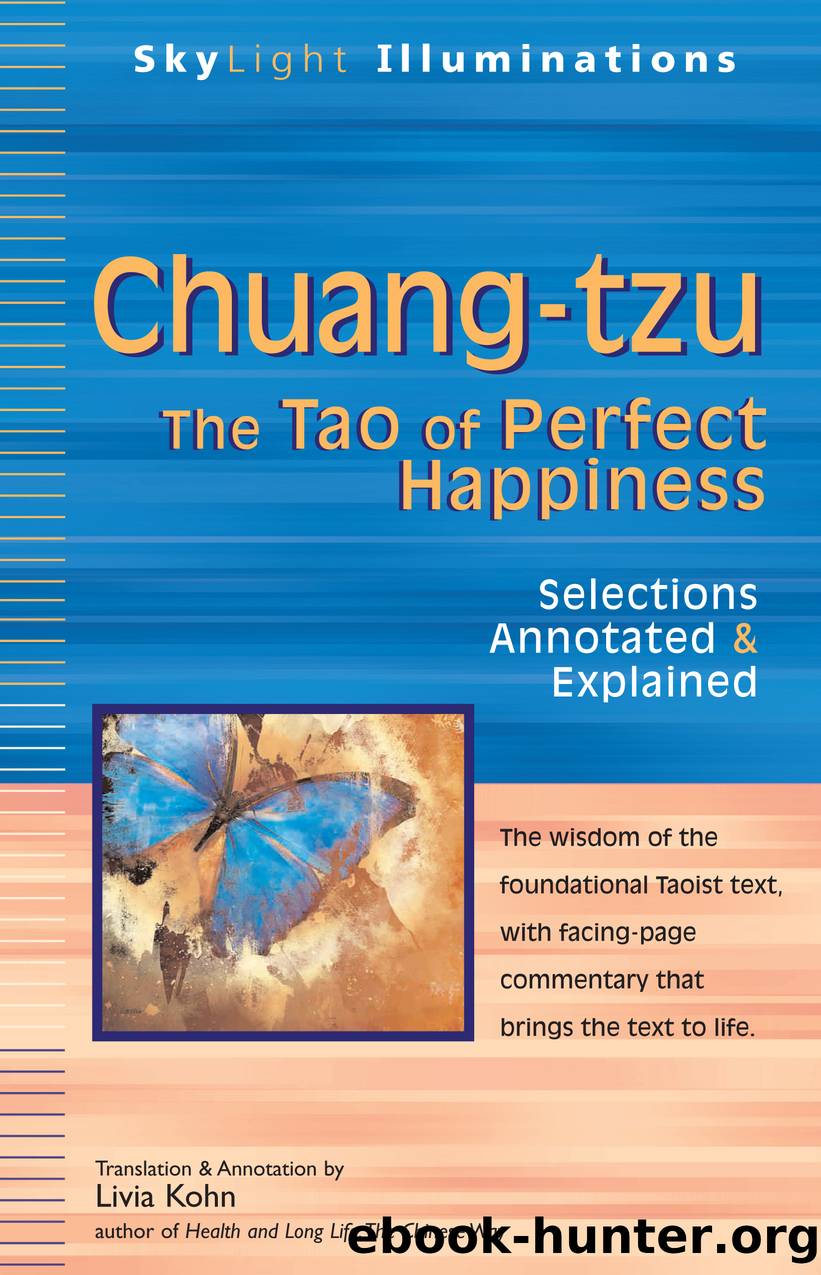Chuang-tzu: The Tao of Perfect Happiness--Selections Annotated & Explained by Livia Kohn PhD

Author:Livia Kohn, PhD
Language: eng
Format: epub
Publisher: SkyLight Paths Publishing
Published: 2011-03-10T16:00:00+00:00
Life and Death: Annotations
1How, then, do we go about getting to this ideal state? The first step is to realize that the entire universe, and thus also our own body and mind, our life and death, are nothing but vital energy (ch’i). In ancient sources associated with mist, fog, and moving clouds, the word consists of an image of someone eating and grain in a pot. Ch’i is thus the quality that nourishes, warms, and transforms as well as anything perceptible but intangible: atmosphere, smoke, aroma, vapor, a sense of intuition, foreboding, or even ghosts.
There is only one ch’i, just as there is only one Tao. But it appears on different levels, most importantly primordial ch’i, which we receive from heaven through our parents, and postnatal ch’i, which we get from the environment through breath, food, and interaction with others. All existence is nothing but ch’i, which flows continuously in a rhythm of yin and yang and should be smooth, even, and ever changing. (back to text)
2On the other hand, any excess or deficiency in the flow, in the inherent transformation pattern, is a form of disturbance that manifests as disease. Seeing things as good and bad, spiritual and putrid, and whining about them, then, is a basic form of imbalance that keeps you from realizing your true nature and causes not only discontent but also disease. (back to text)
3The countermeasure is to use the concept of ch’i to realize the fundamental oneness of all existence and stop seeing yourself as separate. This, then, will also allow you to see death as part of the continuous flow of existence. (back to text)
4Another way to counteract the tendency to “whine” about death is to ask whether we really know what happens after we die. Or, as the Chuang-tzu says in chapter 2, “How do we know that loving life is not a delusion? That hating death is not being like someone who has lost his way and cannot find his home?”
The skull story is a case in point. It was highly unusual to find human remains by the roadside in traditional China, where people had to be buried with all the proper rites to make sure they arrived safely in the otherworld and could receive appropriate offerings and not bother the living for sustenance or attention. The reasons the Chuang-tzu lists here are all possible causes for not dying properly, in the arms of the person’s kin—different ways of being cast out, which, according to classical belief, also means a particularly nasty and unsettled existence in the otherworld. (back to text)
5Despite his outcast status, the skull asserts that life after death is great fun and a form of perfect happiness—the kind of happiness we pursue all our life (harmony, equality, prosperity)—and means the end of toil without the loss of identity or the ability to feel. It is not a fall into some deep abyss; it is not a shadow existence; it is not a form of punishment or deprivation.
Download
This site does not store any files on its server. We only index and link to content provided by other sites. Please contact the content providers to delete copyright contents if any and email us, we'll remove relevant links or contents immediately.
The remains of the day by Kazuo Ishiguro(7587)
Tools of Titans by Timothy Ferriss(6983)
The Black Swan by Nassim Nicholas Taleb(6221)
Inner Engineering: A Yogi's Guide to Joy by Sadhguru(5923)
Giovanni's Room by James Baldwin(5910)
The Way of Zen by Alan W. Watts(5818)
The Six Wives Of Henry VIII (WOMEN IN HISTORY) by Fraser Antonia(4807)
The Power of Now: A Guide to Spiritual Enlightenment by Eckhart Tolle(4781)
Astrophysics for People in a Hurry by Neil DeGrasse Tyson(4634)
Asking the Right Questions: A Guide to Critical Thinking by M. Neil Browne & Stuart M. Keeley(4612)
12 Rules for Life by Jordan B. Peterson(3762)
The Ethical Slut by Janet W. Hardy(3524)
Skin in the Game by Nassim Nicholas Taleb(3489)
Housekeeping by Marilynne Robinson(3428)
The Art of Happiness by The Dalai Lama(3400)
Double Down (Diary of a Wimpy Kid Book 11) by Jeff Kinney(3292)
Skin in the Game: Hidden Asymmetries in Daily Life by Nassim Nicholas Taleb(3280)
Walking by Henry David Thoreau(3242)
12 Rules for Life: An Antidote to Chaos by Jordan B. Peterson(3211)
